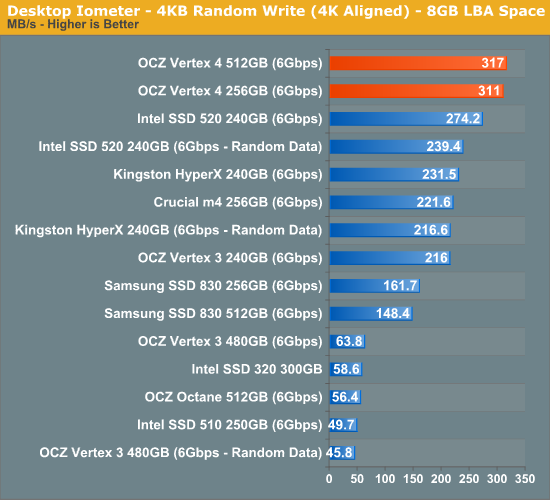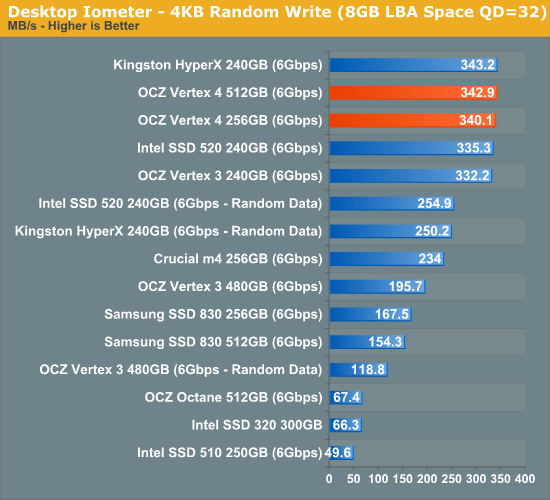OCZ Vertex 4 Review (256GB, 512GB)
by Anand Lal Shimpi on April 4, 2012 9:00 AM ESTRandom Read/Write Speed
The four corners of SSD performance are as follows: random read, random write, sequential read and sequential write speed. Random accesses are generally small in size, while sequential accesses tend to be larger and thus we have the four Iometer tests we use in all of our reviews.
Our first test writes 4KB in a completely random pattern over an 8GB space of the drive to simulate the sort of random access that you'd see on an OS drive (even this is more stressful than a normal desktop user would see). I perform three concurrent IOs and run the test for 3 minutes. The results reported are in average MB/s over the entire time. We use both standard pseudo randomly generated data for each write as well as fully random data to show you both the maximum and minimum performance offered by SandForce based drives in these tests. The average performance of SF drives will likely be somewhere in between the two values for each drive you see in the graphs. For an understanding of why this matters, read our original SandForce article.
Random read performance is staggering - a good 40% higher than anything else we've tested. While the cutoff for usefulness on a client drive is likely much lower than what even the Octane could deliver, this sort of performance bodes very well for OCZ's enterprise ambitions.
Randomly write performance is also just excellent. SandForce's peak numbers come close, but throw in any sort of incompressible data and they quickly take a step back while the Vertex 4 is able to deliver. Again, I'm actually more interested in these numbers from an enterprise workload standpoint but heavy client users will definitely not be disappointed.
Many of you have asked for random write performance at higher queue depths. What I have below is our 4KB random write test performed at a queue depth of 32 instead of 3. While the vast majority of desktop usage models experience queue depths of 0 - 5, higher depths are possible in heavy I/O (and multi-user) workloads:
SandForce always scaled well at higher queue depths, but again we're looking at best case performance for the SF-2281. Move towards incompressible data and the Vertex 4 is alone at the top.













127 Comments
View All Comments
iceman98343 - Thursday, April 5, 2012 - link
also listed at newegg for $179.99iceman98343 - Thursday, April 5, 2012 - link
please delete the above comment.DukeN - Thursday, April 5, 2012 - link
Until this has been out a year, that's all this amounts to.I'd rather pay for Intel/Crucial reliability than be OCZ's unpaid beta tester.
ceast3 - Monday, April 9, 2012 - link
The previous poster was correct, OCZ fixed the BSOD problem, not intel. Sandforce then released their fix to the other Manufacturers. Sandforce was the problem.... fact. So far all feedback is great with the Vertex 4, if that continues until Ivy Bridge and nothing better comes out, I'll be getting one! Vertex 3 and all other SF-2000 based SSD's showed problems right away, so I'm not worried.alfatekpt - Monday, April 9, 2012 - link
Why is your recommendation the Samsung's SSD 830 instead of OCZ vertex 3?Reliability?
Snigel - Sunday, April 22, 2012 - link
It's interesting to see the max values of power consumption, but it would also be interesting to factor in the speed of the drives.Usually a desktop user have a fixed amount of data that the disk needs to transfer, so continous load wattage is not that interesting compared to how much energy that is required to get the job done.
wattage * transfer time
For continous loads it would be more interesting to see something like
transfer speed / wattage
How much performance do I get compared to the energy I put in?
I could do these calculations manually of course, but I don't know how the write tests in the power consumption part are performed, so I cannot get the speed data from other charts.
vegemeister - Monday, May 7, 2012 - link
An SSD will be idle nearly all the time in nearly all desktop and laptop use cases. When the idle power consumption is > 1W, it doesn't much matter what the load power consumption is.Winning29 - Monday, April 30, 2012 - link
Hey guys. Check out my OCZ Vertex 4 speed test on YouTube. It shows my home PC's boot up time, then I load a VDI environment running on Citrix XenApp and VMware Workstation.http://youtu.be/YrnIcudM7zo
I'd welcome any comments, feedback or questions.
Bluemars_ - Tuesday, May 8, 2012 - link
New firmware 1.4's out, does it fix the low queue depth sequential read performance?twindragon6 - Friday, June 29, 2012 - link
From OCZ's website."CURRENT FIRMWARE RELEASE is v1.4.1.3"
I'm curious to see how this drive performs now with the newer firmware.